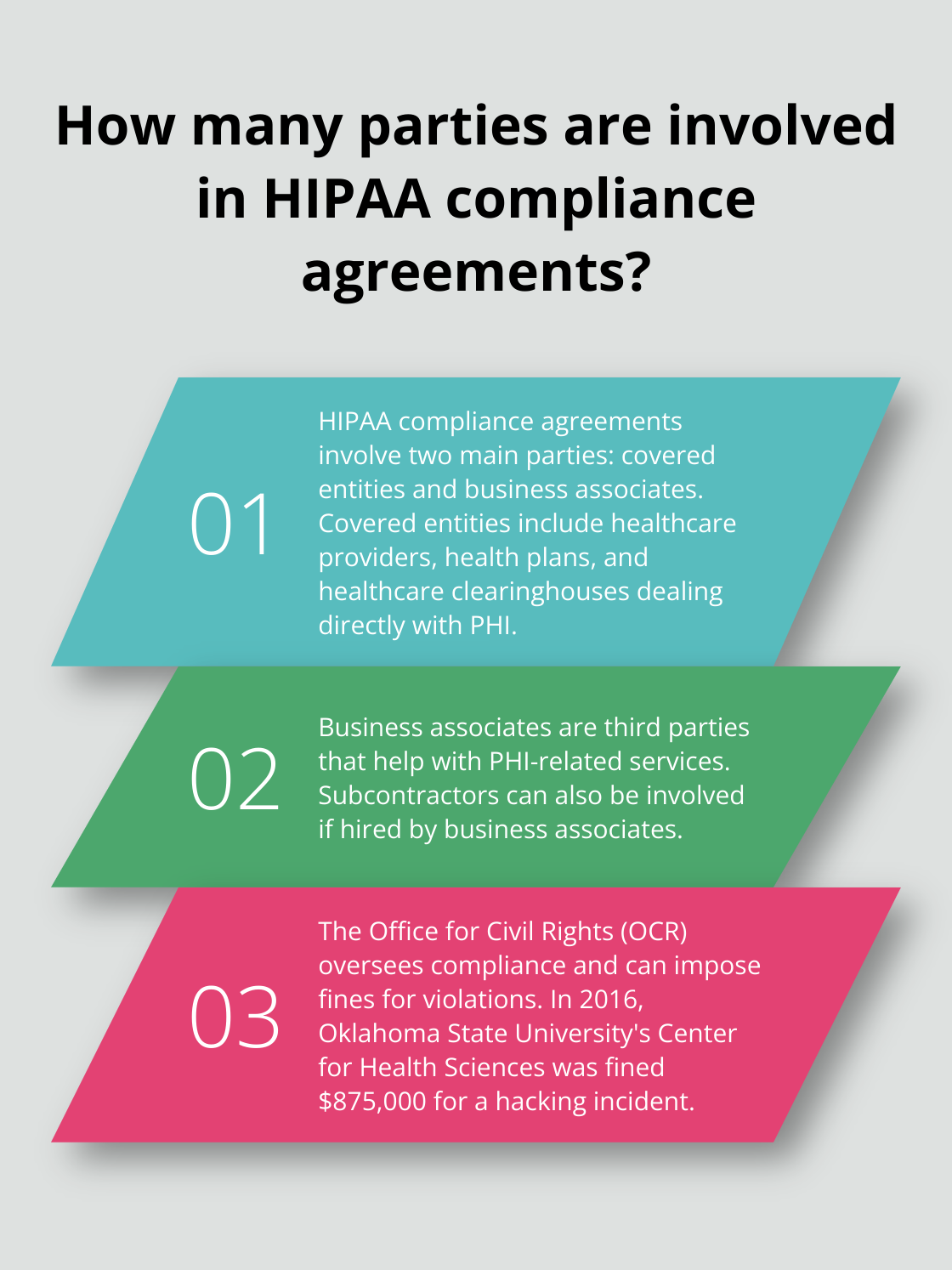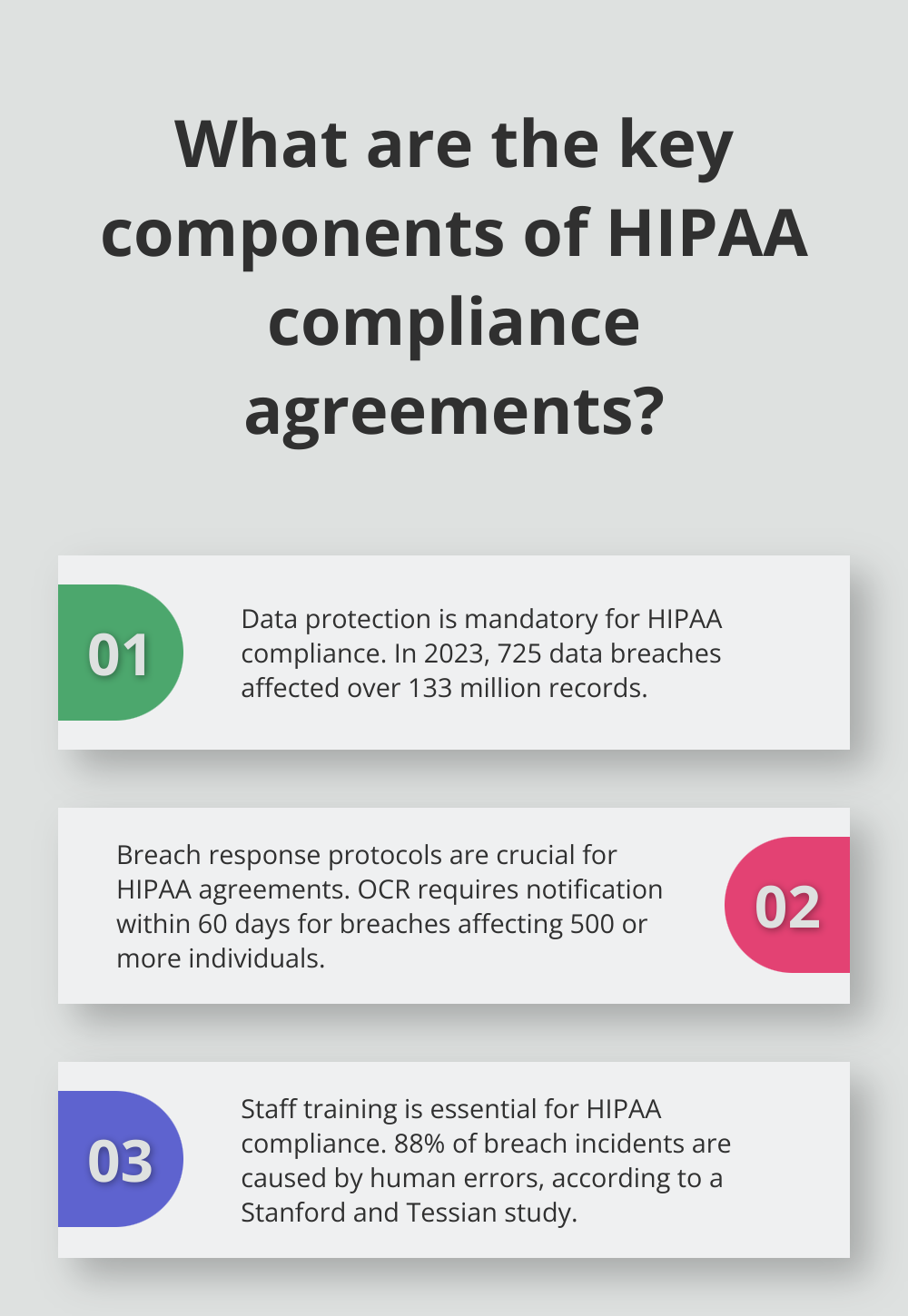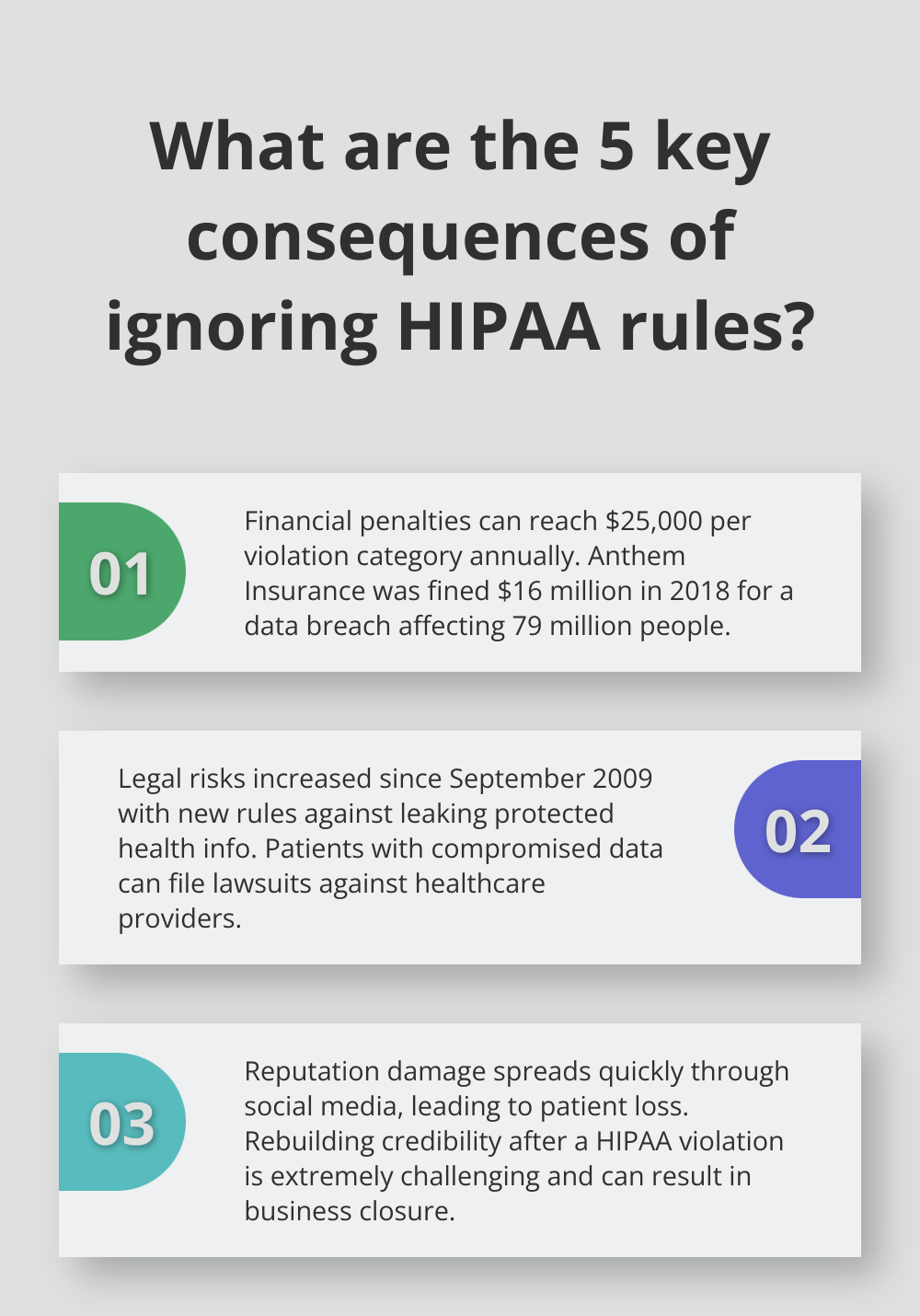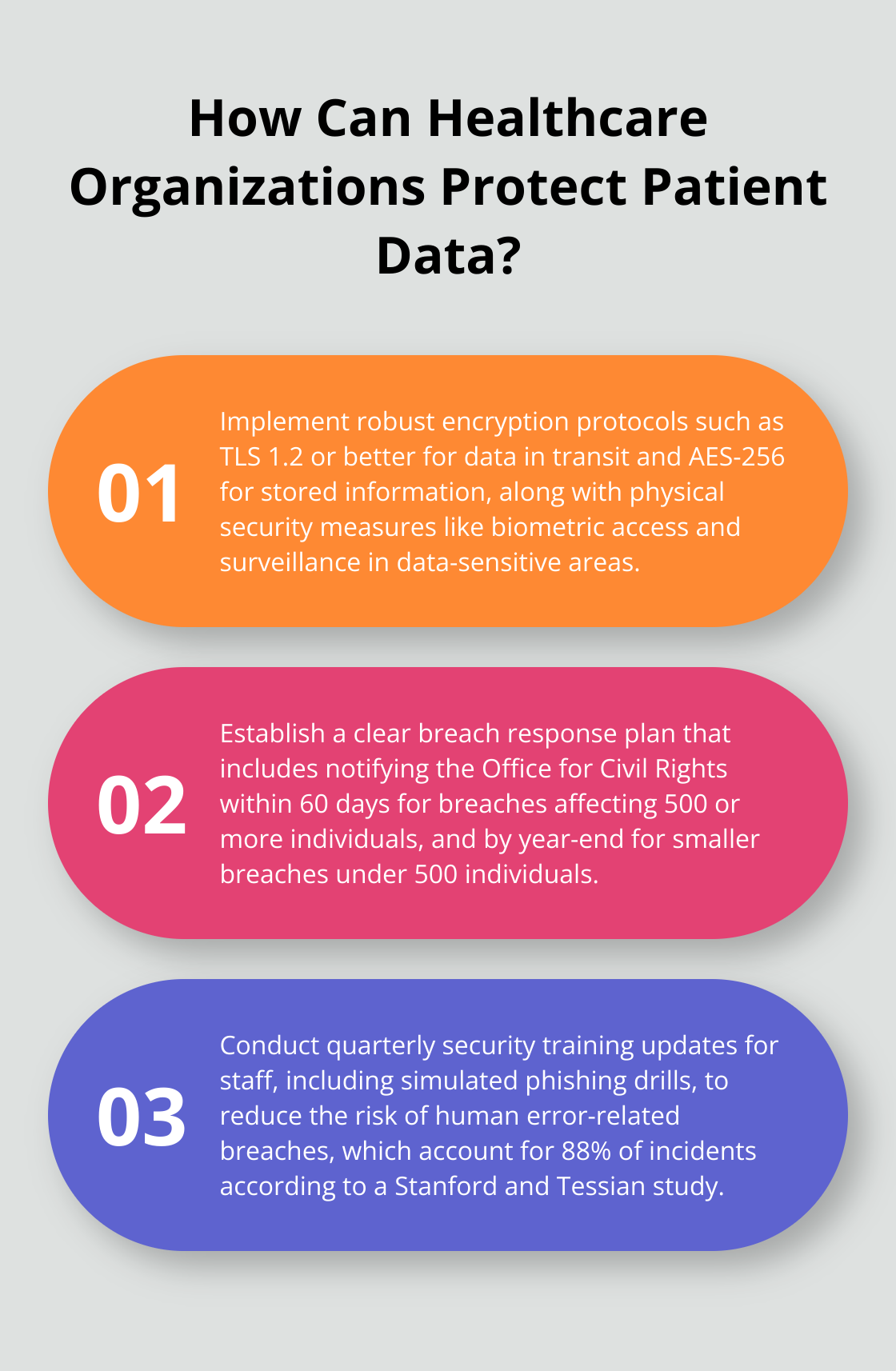HIPAA compliance agreements—fun stuff, right? But seriously, they’re crucial for keeping our sensitive health info under lock and key in the healthcare world. They spell out who’s gotta do what (and not do what) when it comes to keeping patient data safe—the whole covered entities and business associates dance.
So, here’s the deal: at ScriberJoy, we totally get it. HIPAA compliance is a biggie for healthcare organizations. Our mission? To walk you through the big stuff in HIPAA compliance agreements and help you make sense of the tangled web of data protection in healthcare. Buckle up, it’ll be a journey… but one that’s worth it.
What Are HIPAA Compliance Agreements?
Definition and Purpose
HIPAA compliance agreements-what on Earth are they? Think of them as detailed playbooks (or maybe safety nets?)… that hold organizations accountable for handling protected health information (PHI). They’re like blueprints, guiding the way for safeguarding sensitive medical data within the healthcare universe. These documents spell out exactly what hospitals, insurance companies-your standard covered entities-and their business pals like billing companies and cloud providers need to do to keep that info buttoned up.
Key Components
Your typical HIPAA compliance agreement? It’s got a few big-ticket items:
- Permitted Uses and Disclosures: This part? It lays down the ground rules-who can do what with that data and when they can share it. Clear as day.
- Security Measures: Here we get into the nitty-gritty… the tech stuff. Encryption, access controls, regular checkups-a whole laundry list of security to-dos. (Imagine a world where a business associate must employ 256-bit AES encryption and multi-factor authentication… yeah, that’s this world.)
- Breach Notification Procedures: If something fishy-or worse, a breach-happens, business associates gotta pick up the phone. How quick? Often within 24 hours. Tick-tock.
Parties Involved
Now, who are the big players in these agreements?
- Covered Entities: The frontliners-healthcare providers, health plans, and healthcare clearinghouses dealing directly with PHI.
- Business Associates: These guys? They’re the third party, swooping in to help out with PHI-heavy services.
The responsibility train doesn’t stop there. Suppose a business associate decides to get another player on board-a subcontractor. They better loop them into this HIPAA agreement web too. It’s like a protective chain, each link crucial for PHI security.
Practical Implications
These agreements-oh boy, they can be labyrinthine. Picture this: a hospital (our covered entity) hires a medical billing company (our business associate), which then stores records with a cloud storage provider (our subcontractor). Each step here? Needs its own HIPAA playbook.

Worth noting: the Office for Civil Rights (OCR) is watching more closely than ever-especially the business associates. Remember back in 2016, when Oklahoma State University’s Center for Health Sciences got slapped with an $875,000 fine post-hacking incident? Yep, a wake-up call.
To steer clear of those flashing red penalty alarms, both covered entities and business associates should keep their HIPAA agreements under constant review. Keep ‘em fresh, relevant, and ready to tackle any emerging cyber villains.
As we forge ahead, aligning with what’s expected in these agreements becomes critical. So, let’s dig deeper into the specific requirements these HIPAA compliance agreements usually spell out.
What Must HIPAA Compliance Agreements Include?
HIPAA compliance agreements are like the backbone of data protection in healthcare. They’re not just a bunch of legal mumbo jumbo-they’re essential blueprints that help keep patient info safe and companies in line. So, what’s the nitty-gritty that every HIPAA compliance agreement should cover?
Robust Data Protection Measures
First up, data protection measures-these are front and center for HIPAA. No, they’re not optional; they’re mandatory safeguards putting a lock and key on personal health info and setting boundaries on who gets to see what. In 2023, a whopping 725 data breaches were reported, hitting over 133 million records-enough to give anyone a wake-up call on the need for some rock-solid protection.

HIPAA calls for top-notch encryption both when data’s just sitting there and when it’s on the move. We’re talking about using protocols like TLS 1.2 or better for moving data around and AES-256 for info that’s in storage. There’s also the whole physical side-yep, think biometric access and surveillance in data-sensitive areas.
Immediate Breach Response Protocols
When data breaches hit, it’s all about speed. HIPAA agreements need a clear, fast-moving game plan ready to roll out as soon as a breach shows up. The Office for Civil Rights (OCR) isn’t playing around-they’ve got strict rules on breach notifications:
- For breaches hitting 500 or more: Shout out to OCR within 60 days
- Smaller ones (under 500): Wrap it up by the end of the year
Moving quickly here not only minimizes the mess but shows regulatory folks you’re on your game.
Comprehensive Staff Training Programs
Staff training-it’s your first line of defense. HIPAA agreements should spell out ongoing, robust training programs that keep pace with new threats. Once-a-year training? That’s the starting line. Top-tier organizations shoot for quarterly updates and throw in some simulated phishing drills for good measure.
Why this matters? Well, nine in 10 (88%) breach incidents boil down to human slip-ups, according to a study by Stanford and Tessian. Regular training slashes that risk, building a solid, security-minded team.
Stringent Access Controls
HIPAA agreements need to lay down the law on who can access data, when, and how. Multi-factor authentication should be the standard-not a nice-to-have. Role-based access control (RBAC), anyone? It’s all about folks only seeing the data necessary for their gig.
It doesn’t stop there; agreements should also require detailed audit logs. These logs need to catch every login, file peek, and data tweak-offering up a full trail of system activity.
Regular Audits and Meticulous Documentation
“If it didn’t get written down, it’s like it never happened”-that’s the mantra for HIPAA compliance. Agreements must insist on regular internal and external audits to keep eyes on the game and spot any potential weak spots.
Documentation isn’t just a checkbox exercise. It’s your lifeline for OCR investigations. Every single policy, procedure, and training session needs to be recorded with precision. Regularly reviewing and updating these docs ensures they keep pace with the ever-evolving threat landscape.
As we dive deeper, we’ll explore what happens when organizations drop the ball on these critical HIPAA compliance agreement requirements. Stakes are sky-high, penalties steep, underscoring the need for a thorough understanding and execution of these agreements.
What Happens When You Ignore HIPAA Rules?
Financial Consequences
Blow off HIPAA rules – and watch your finances take a nosedive. The Office for Civil Rights (OCR) isn’t messing around; they slap hefty fines on violators, sometimes up to $25,000 per violation category… every single year. Think you’re safe because you’re small-time? Ha! In 2018, Anthem Insurance got walloped with a $16 million fine for a data breach hitting 79 million people. This isn’t just for healthcare giants – even small practices aren’t spared from these financial sucker punches.

All it takes is one surprise inspection to catch you off guard, and BAM – penalties raining down. Accidental slip-ups? Yeah, they cost big too. Long story short: Compliance isn’t just a good idea… it’s survival.
Legal Ramifications
But wait, there’s more – HIPAA violations? Say hello to legal headaches. Patients with compromised data can lawyer up and slap you with a lawsuit. Since September 2009, there are new rules against leaking protected health info – like you need more problems, right? This means the legal risk for healthcare providers is like a ticking time bomb.
And surprise, surprise: the legal terrain keeps shifting. More states are hopping on the HIPAA bandwagon. Want to dodge legal grenades? Stay sharp, stay compliant.
Reputation Damage
Ah, reputation… trust is the real MVP these days. Mess up with a HIPAA violation, and your good name goes down faster than the Titanic. Data breaches, privacy SNAFUs – thanks to social media, the news spreads like wildfire. Patients talk, and bad reviews stick.
Rebuilding credibility after a HIPAA blunder? Yeah, good luck with that uphill climb. Burned trust means patients head for the exit, and new ones won’t touch you with a ten-foot pole. Sometimes, the fallout’s so bad, it’s game over – lights out, doors closed.
Increased Oversight
Slip up with compliance, and you’re signing up for a VIP welcome to the oversight circus. Expect corrective action plans (CAPs) to be the new norm. These demand major operational rejigs, staff boot camps, constant check-ins with regulatory guys. CAPs – time sinks and budget busters.
Here’s the CAP drill:
- Regular audits (yup, inside and out)
- Staff retraining (because, why not?)
- New security measures (welcome to the future)
- Nonstop reporting to OCR
All this heightened oversight bleeds resources, wrecks focus, and drags down patient care quality. Fun, huh?
Operational Disruptions
HIPAA mishaps? They throw a wrench into your daily grind. Investigations (post-breach) eat time, sanity, and manpower – forcing staff into paperwork mode.
Worst-case scenario? OCR makes you shut down certain ops until you’re back on track. Cue:
- Revenue loss
- Ticked-off patients
- Staff reshuffling (or worse)
- Shaky partnerships
The shockwaves from these operational snafus can haunt you for years. Moral of the story: prevention (via airtight HIPAA compliance) is the winning play.
Final Thoughts
HIPAA compliance agreements – the bedrock of data protection in healthcare. These aren’t just documents; they’re guardians of patient info, trust builders, and shields against fines and litigation. They even sharpen data management practices and boost operational mojo, casting healthcare providers as vigilant stewards of delicate data.

Organizations gotta stay on their toes – proactive steps to guard personal health info are non-negotiable. Think continued risk evaluations, staff schooling, and keeping those policies fresh. Toss in airtight security measures like encryption and access controls, too. Healthcare folks need to keep a finger on the pulse of changing HIPAA rules and industry gold standards to sustain top-tier care and privacy.
Over at ScriberJoy, we totally get the HIPAA compliance jungle in healthcare documentation. Our medical transcription software fuses AI magic with human fact-checking to churn out spot-on, HIPAA-compliant medical records. This slick transcription gig lets healthcare pros zero in on patient care while ticking all the HIPAA boxes (agreements included).

Leave a Reply
You must be logged in to post a comment.